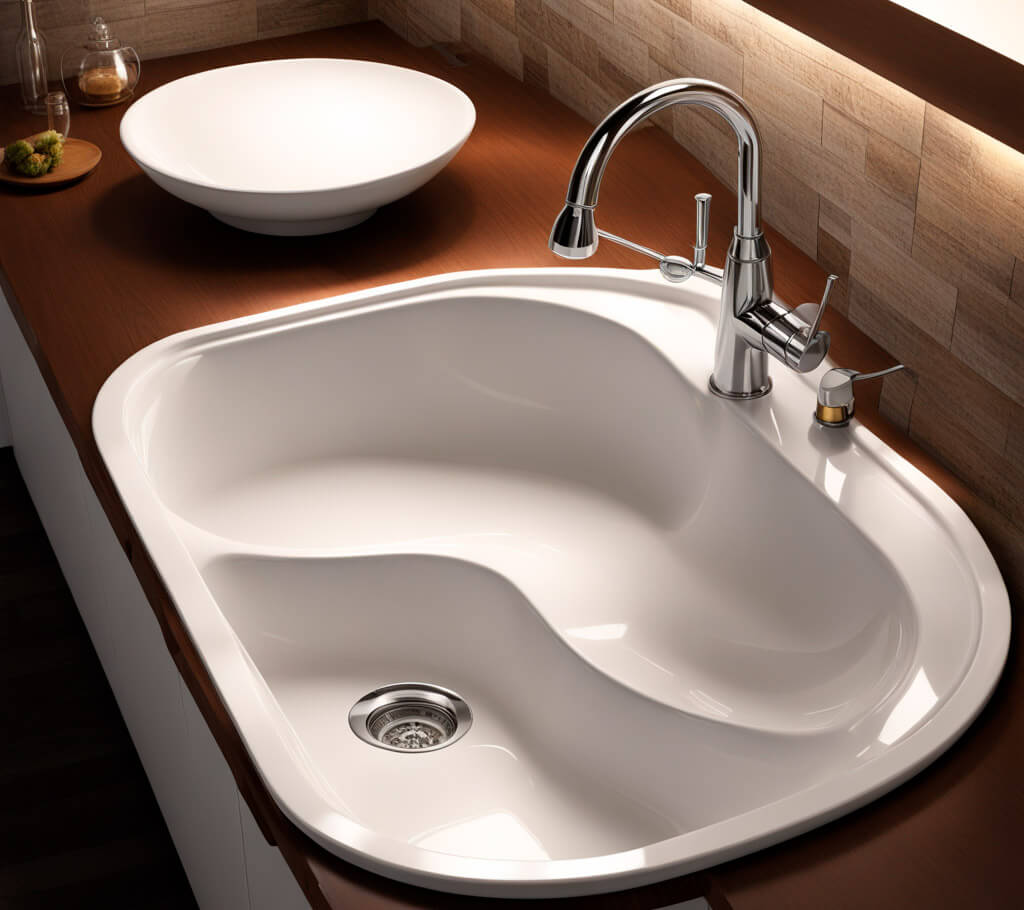When it comes to keeping your home in prime condition, one aspect that’s often overlooked is the humble porcelain sink. It’s a central fixture in our daily lives, but we don’t always give it the care it deserves. For the savvy home handyman and the self-employed pros out there, understanding and maintaining these sinks is key. It’s not just about aesthetics, it’s about preserving a piece of your home’s functionality and value. Let’s roll up our sleeves and get into the nitty-gritty of porcelain sink maintenance.

Understanding Porcelain Sinks
Porcelain, a refined form of ceramic, is the go-to choice for sinks due to its resilience and glossy finish. However, its maintenance is a bit like walking a tightrope. On the one hand, porcelain is known for its durability and resistance to fading. On the other, it can be susceptible to scratches and stains if not treated with care. The trick here is to strike a balance between regular cleaning and gentle handling, ensuring your sink stays in pristine condition for years.
Pre-Cleaning Steps
A good job starts with good prep. Here’s how to set yourself up for success:
- Safety Considerations: Porcelain can get slippery. A pair of shoes with a good grip can prevent mishaps.
- Clearing the Area: Remove all your bathroom or kitchen items from the sink. This gives you unobstructed access and ensures nothing gets damaged.
- Initial Inspection: Take a moment to inspect the sink for any damage, like chips or cracks. These areas will need extra gentle care to avoid worsening the damage during cleaning.

Materials and Tools Needed
The right tools can make all the difference. Here’s what you’ll need:
- Gentle Cleaning Agents: Choose non-abrasive cleaners that won’t damage the porcelain’s finish. Imagine you’re detailing a classic car – you wouldn’t use anything that could scratch the paint.
- Tools:
- Soft sponges: These are perfect for most of the cleaning, gentle yet effective.
- Microfiber cloths: Ideal for drying and buffing the sink to a shine.
- Soft brushes: An old toothbrush can be your best friend for scrubbing around faucets and other hard-to-reach spots.
- Natural Solutions: For an eco-friendly approach, baking soda and vinegar can be surprisingly effective, especially for tackling tough stains without damaging the porcelain.
By following these guidelines, you’ll ensure your porcelain sink stays in great shape, retaining its functionality and aesthetic appeal. Remember, the key to successful home maintenance is in understanding the materials you’re working with and treating them with the respect they deserve.
Step-by-Step Cleaning Process
In my many years navigating the twists and turns of home renovation, I’ve learned that the beauty of a well-maintained porcelain sink lies in the details of its cleaning process. It’s a task that requires precision and patience. Here’s how you do it:
- Wetting the Sink and Applying Cleaner: Start by moistening the sink with lukewarm water. It’s similar to prepping a wall before painting, you’re setting the stage. Then, apply a gentle, non-abrasive cleaner evenly across the surface. This step is crucial for loosening dirt and grime without damaging the porcelain.
- Techniques for Gentle Scrubbing: With a soft sponge in hand, work in circular motions. This technique is akin to gentle sanding, where the goal is to lift off dirt rather than scour the surface. Areas around the drain and faucet often hide more grime, so give them special attention.
- Paying Attention to Stains and Hard-to-Reach Areas: For those stubborn stains and tight corners, use a soft brush or toothbrush. It’s a delicate balance between applying enough pressure to clean and being gentle enough to protect the porcelain. Each stain and corner requires a nuanced approach, just like dealing with unique challenges in a renovation project.
- Rinsing and Drying the Sink: After scrubbing, thoroughly rinse the sink with warm water to remove all traces of the cleaner. Then, use a microfiber cloth to dry it off, preventing water spots. This step is as important as any finishing touches in a renovation – it defines the final look.

Advanced Cleaning Techniques
Dealing with tough stains requires a blend of the right products and techniques:
- Addressing Tough Stains: For rust stains, a porcelain-safe rust remover is your best option. Apply it with care, following the product’s instructions. To tackle mineral deposits, white vinegar is remarkably effective. Soak a rag in vinegar, lay it on the stain, wait, and then scrub gently.
- Using Specific Products for Stubborn Stains: For particularly stubborn stains, seek out products labeled safe for porcelain. They should be used as per the instructions, always testing on a small area first. It’s similar to how you’d approach using a new material or technique in a renovation – cautiously and with respect for the medium.
Regular Maintenance Tips
Consistent maintenance is key to longevity, just as it is in any renovation or construction project:
- Daily and Weekly Maintenance Routines: A daily wipe-down with a soft, damp cloth can prevent dirt accumulation. Weekly, a more thorough cleaning with your gentle cleaner will keep the sink in top condition.
- Preventive Measures to Keep the Sink in Good Condition: Prevent rust by not leaving metal cans or containers on the sink’s surface. Also, remember that a porcelain sink is not a cutting board or a place to bang pots and pans. Respect for the material is paramount, much like respecting the integrity of a home you’re renovating.

Do’s and Don’ts
In my extensive experience with home renovations, I’ve come to appreciate the nuances of maintaining various fixtures, including porcelain sinks. Here’s a distilled list of do’s and don’ts:
- Do’s:
- Opt for Gentle Cleaners: Just like you would carefully select a sealant for a delicate wood surface, choose non-aggressive cleaners for your porcelain.
- Regular Cleaning: Regular maintenance is key, akin to routinely checking your power tools for wear and tear.
- Use Soft Cleaning Tools: Employ soft sponges or cloths, treating your sink as you would a finely finished piece of furniture.
- Don’ts:
- Avoid Harsh Chemicals: These can damage the sink’s surface, much like how a too-strong solvent can strip away a wood finish.
- Steer Clear of Abrasive Scrubbers: Just as you wouldn’t use a coarse sandpaper on a smooth veneer, avoid anything that can scratch your sink.
- No Heavy-Duty Tools: The sink isn’t a construction site, avoid tools that are too harsh for its delicate surface.
Troubleshooting Common Issues
Even with the best care, issues can arise. Here’s how to address them, based on what I’ve learned:
- For Dullness: A mix of water and white vinegar often does the trick, much like a polish would rejuvenate a dulled wood surface.
- For Minor Scratches: Apply a small amount of a non-abrasive gel cleaner and gently buff with a soft cloth, reminiscent of smoothing a fine scratch on a wooden floor.
- For Persistent Stains: A paste of baking soda and water can be effective, similar to gently sanding out a flaw in a woodwork project.
FAQ Section
Bleach can be too harsh, much like a potent chemical stripper on wood, and may damage the porcelain. Opt for milder alternatives for safety and effectiveness.
Gently buffing the area with a non-abrasive cleaner is akin to using a fine-grit sandpaper on a delicate wood surface – it can be quite effective for minor scratches.
Yes, vinegar can be an effective cleaner, similar to how a diluted solvent works on certain paint types. However, it should be used sparingly and always rinsed thoroughly.
A daily light cleaning and a more thorough weekly cleaning is like the routine maintenance needed to keep your power tools in optimal condition.
If regular methods fail, consider specialized porcelain cleaning products or professional assistance. This is comparable to consulting a specialist for complex renovation tasks.
